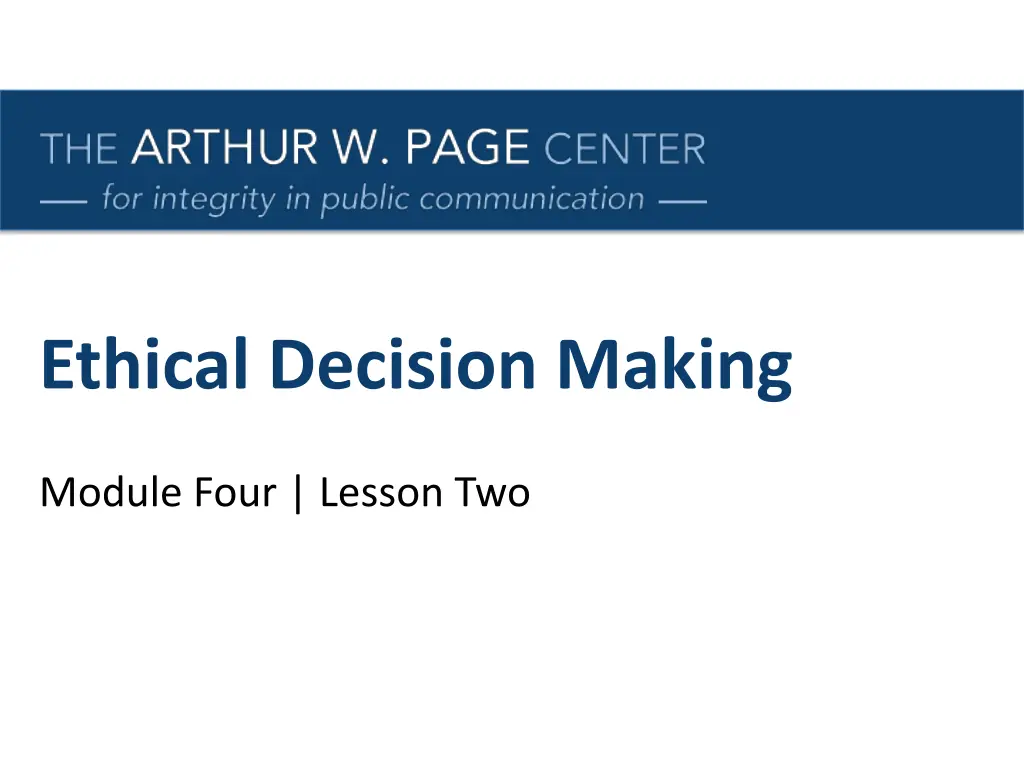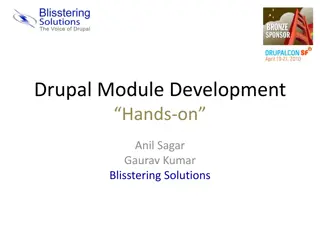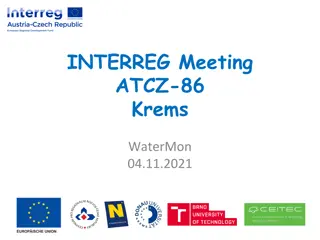
Understanding the Relationship Between Ethics and Decision-Making
Explore the intricate relationship between ethics and decision-making, diving into the process of ethical decision-making, group dynamics' influence, and dominant incentives in individual decision-making. Reflect on your own decision-making experiences and learn how ethics guide decision-making processes.
Download Presentation

Please find below an Image/Link to download the presentation.
The content on the website is provided AS IS for your information and personal use only. It may not be sold, licensed, or shared on other websites without obtaining consent from the author. If you encounter any issues during the download, it is possible that the publisher has removed the file from their server.
You are allowed to download the files provided on this website for personal or commercial use, subject to the condition that they are used lawfully. All files are the property of their respective owners.
The content on the website is provided AS IS for your information and personal use only. It may not be sold, licensed, or shared on other websites without obtaining consent from the author.
E N D
Presentation Transcript
Ethical Decision Making Module Four | Lesson Two
Lesson Two | Application What is the relationship between Ethics and Decision-Making? Ethics exist as a means of making decisions about issues of good and bad, right and wrong. Decision-making is informed by ethics. Ethical decisions are difficult to make and require research and hard work.
Lesson Two | Application What is the basic process of making decisions according to Dewey? Step 1: Identify the decision to be made. Step 2: Gather relevant information. Step 3: Identify alternatives. Step 4: Weigh evidence. Step 5: Choose among alternatives. Step 6: Take action. Step 7: Review decision and consequences.
Lesson Two | Application Discussion Question Q: Thinking back to the last decision that you made, did you follow this model?
Lesson Two | Application How do group-dynamics influence the decision-making process? Personalities, work preferences, interest, and other variables influence productivity. Cultural differences can influence the decision-making process. Time, resources, and knowledge influence the quality of decisions.
Lesson Two | Application Discussion Question Q: Thinking back on your group experiences, why have certain groups been more successful than others?
Lesson Two | Application What makes a decision ethical? The process is guided by a decision making process, such as Dewey s model. The process is informed by research and information gathering. Individual decision makers bring to bear their own ethical frameworks.
Lesson Two | Application FACTORS INVOLVED IN INDIVIDUAL DECISION MAKING: Dominant Incentive The one thing that someone wants or cares about more than anything else.
Lesson Two | Application Discussion Question Q: What would you say your dominant incentive is as a college student?
Lesson Two | Application Rational Choice The assumption, not always true, that people act to achieve desirable consequences. In real life, however, people are often swayed by appearances, social desirability, etc. and do not make rational decisions.
Lesson Two | Application Discussion Question Q: How rational are your decisions? What factors influence you when deciding on purchases?
Lesson Two | Application Framing The way something is described influences how people think about it.
Lesson Two | Application Groupthink When highly cohesive groups start thinking that whatever they believe is always right, and stop asking for input from outsiders or questioning their decisions. Only applies to highly cohesive groups.
Lesson Two | Application Discussion Question Q: Think back on the last election and how one candidate described an issue, and how his/her opponent described the same issue? How might things have been different if either candidate had used different framing strategies?
Lesson Two | Application Cognitive Misers People who seize on the first acceptable solution that comes along and then just justify it based on their existing knowledge. Although cognitive misers often solve problems effectively, they do not spend time searching for the best solution, only the most expedient.
Lesson Two | Application Discussion Question Q: Are you a cognitive miser or do you work to achieve the best solution?
Lesson Two | Application Heuristics and Biases Heuristics are rules of thumb, based on past experiences, that people use to make decisions. Biases, like heuristics, are also based on past experience, but are also grounded in a number of positive and negative personal experiences.
Lesson Two | Application Discussion Question Q: What kinds of heuristics guide your decision making when choosing a restaurant or a movie? What kinds of biases? Are any of your heuristics or biases problematic or do they always work?
Lesson Two | Application Decision-Making by Objection When a group follows a decision-making suggestion that a member has made, simply because everyone in the group is unwilling to speak out.
Lesson Two | Application Uncertainty and Risk Uncertainty refers to things that are unknown, and difficult or impossible to judge. Risk refers to things that are known and therefore can be predicted and more easily acted upon. Risk is preferable to uncertainty.
Lesson Two | Application Discussion Question Q: Think about a decision that involves uncertainty and one that involves risk. What could be done to make the uncertain situation more certain?
Lesson Two | Application Rationality Goal-oriented behavior. Most people are capable of rationality, but often decisions and actions taken by people are not rational, but are based on external factors: peer pressure, likability, attractiveness, etc.
Lesson Two | Application Discussion Question Q: How rational are you compared to your family or friends? Are your decisions always taken to achieve long-term or short-term goals, or do you just go with the flow?
Lesson Two | Application Clinical and Actuarial (Statistical) approaches Clinical approaches to decision making are based on humanistic decisions made based on personal experiences with others. Actuarial decisions are made based on probabilities and likelihoods based on data. Actuarial decisions have been shown to be more reliable.
Lesson Two | Application Discussion Question Q: Do you believe you are a good judge of character? If you had to make college admission decisions, would you rather make them based on a personal interview with a student, or based on a combination of factors like their GPA and other past performance?
Lesson Two | Application Base Rate Problem The tendency when confronted with base rate or statistical data and individuated information, to focus on the individual information over the statistical information.
Lesson Two | Application What are the Features of fair Division? Divide and Choose: One party divides and another party selects or chooses. Envy-Freeness: A division of resources whereby all parties feel good about what they receive. Proportionality: Division of resources based on the preferences of other parties as well as general fairness.






















